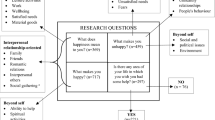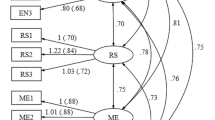Abstract
The purpose of this study is to develop an instrument for measuring the quality of life of university students, and to report its validity and reliability. The study used a representative sample of undergraduate and graduate students in the faculty of education at a major Canadian university. The construct validity of the scales was assessed by Piazza's technique for the analysis of attitude items. The findings supported conceptualizing the quality of life of university students in four dimensions including Positive Affect, Interaction with Students, Interaction with Professors, and Negative Affect. The alpha reliabilities of these scales ranged from 0.75 to 0.93. Some potential applications of this instrument for understanding educational attainment, as well as for the evaluation of university departments and faculties, are mentioned.
Similar content being viewed by others
References
Anderson, C. S.: 1982, ‘The search for school climate: a review of the research’, Review of Educational Research 52, pp. 368–420.
Austin, Gilbert R. and Herbert, Garber: 1985, Research On Exemplary Schools (Academic Press, Orlando, FL).
Boldt, E. D., N. E. Lindquist and A. Percival: 1976, ‘The significance of significant others’, Canadian Review of Sociology and Anthropology 13, pp. 345–351.
Boldt, E. D. and L. W. Roberts: 1979, Structural tightness and social conformity’, Journal of Cross-Cultural Psychology 10, pp. 221–230.
Bohrnstedt, George and David Knoke: 1982, Statistics For Social Data Analysis (F.E. Peacock Publishers, Ithaca, Iliniois).
Brim, Orville G.: 1966, ‘Socialization through the life cycle’ in Orville G. Brim and Stanton Wheeler (eds.), Scocialization After Childhood (John Wiley and Sons, New York), pp. 3–49.
Bulcock, Jeffrey: 1982, ‘School assessment: the middle way’, McGill Journal of Education XVII, pp. 128–143.
Burt, Ronald S., James A. Wiley, Michael J. Minor, and James R. Murray: 1978, ‘Structure of well being’, Sociological Methods and Research 6, pp. 365–407.
Carmines, E. G. and R. A. Zeller: 1979, Reliability and Validity Assessment (Sage University Paper Series on Quantitative Applications in the Social Sciences, series no. 07-017, Sage Publications, Beverly Hills, CA).
Coser, Rose L.: 1979, Training in Ambiguity (The Free Press, New York).
Fraser, Barry J.: 1986, Classroom Environment (Croom Helm, London).
Gibson, Sherri and Maron H. Dembo: 1984, ‘Teacher efficacy: a construct validation’, Journal of Educational Research 76, pp. 569–582.
Herman, H. H.: 1967, Modern Factor Analysis (University of Chicago Press, Chicago, IL).
Jackson, Susan E.: 1981, ‘Measurement of commitment to role identities’, Journal of Personality and Social Psychology 40, pp. 138–146.
Kagitcibasi, C. and J. W. Berry: 1989, ‘Cross-cultural psychology: current research and trends’, Annual Review of Psychology 40, pp. 493–531.
Kim, J. O. and C. W. Mueller: 1978a, Introduction To Factor Analysis: What It Is and How To Do It (Sage University Series on Quantitative Applications in the Social Sciences, series no. 07-013, Sage Publications, Beverly Hills, CA).
Kim, J. O. and C. W. Mueller: 1978b, Factor Analysis: Statistical Methods and Practical Issues (Sage University Series on Quantitative Applications in the Social Sciences, series no. 07-014, Sage Publications, Beverly Hills, CA).
Kleinfeld, Judith S.: 1975, ‘Effective teachers of Eskimo and Indian students’, School Review 83, pp. 301–344.
Levitz, Randy and Noel Lee: 1989, ‘Connecting students to institutions: keys to retention and success’, In M. L. Upcraft, J. N. Gardner & Associates (Eds.) The Freshman Year Experience (Jossey-Bass, San Francisco, CA), pp. 65–81.
Mooney, Carolyn J.: 1991, ‘Crowded classes, student advising system are targets of report on liberal learning’, The Chronicle of Higher Education 17, January 9, pp. A1, A40.
Nachmias, David and Chava Nachmias: 1987, Research Methods In The Social Sciences (St. Martin's Press, NY).
Nunnally, J. C.: 1967, Psychometric Theory (McGraw-Hill, NY).
Piazza, Thomas: 1980, ‘The analysis of attitude items’, American Journal of Sociology 86, pp. 584–603.
Roberts, Lance W. and Rodney A. Clifton: 1988, ‘Inuit attitudes and cooperative learning’, McGill Journal of Education 23, pp. 213–230.
Singleton, R., B. C. Straits, M. M. Straits and R. J. McAllister: 1988, Approaches To Social Research (Oxford University Press, NY).
Smith, Mary Lee and Gene V. Glass: 1987, Research and Evaluation in Education and the Social Sciences (Prentice-Hall, Englewood Cliffs, NJ).
Spady, William and Douglas E., Mitchell: 1979, ‘The uses of authority and power in the organization and control of school task performance’, Symposium conducted at the American Educational Research Assoication.
Stinchombe, A. L.: 1971, ‘A heuristic procedure for interpreting factor analysis’, American Sociological Review 36, pp. 1080–1084.
Stinchcombe, A. L. and J. C. Wendt: 1975, ‘Theoretical domains and measurement in social indicator analysis’. In K. C. Land & S. Spilerman (Eds.) Social Indicator Models (Russell Sage Foundation, NY), pp. 37–73.
Tabachnick, Barbara, G. and Linda S. Fidell.: 1989, Using Multivariate Statistics (Harper and Row, NY).
Upcraft, M. Lee, John N. Gardner and Associates: 1989, The Freshman Year Experience (Jossey-Bass Publishers. San Francisco, CA).
Westhues, Kenneth: 1991, ‘Transcending the textbook world’, Teaching Sociology 19, pp. 84–92.
Williams, Trevor and Margaret Batten: 1981, The Quality of School Life (The Australian Council for Educational Research, Hawthorn, Victoria).
Wilson, Robin: 1991, ‘Undergraduates at large universities found to be increasingly dissatisfied’, The Chronicle of Higher Education 17 January 9, pp. A1, A38.
Author information
Authors and Affiliations
Rights and permissions
About this article
Cite this article
Roberts, L.W., Clifton, R.A. Measuring the affective quality of life of university students: The validation of an instrument. Soc Indic Res 27, 113–137 (1992). https://doi.org/10.1007/BF00300557
Issue Date:
DOI: https://doi.org/10.1007/BF00300557




